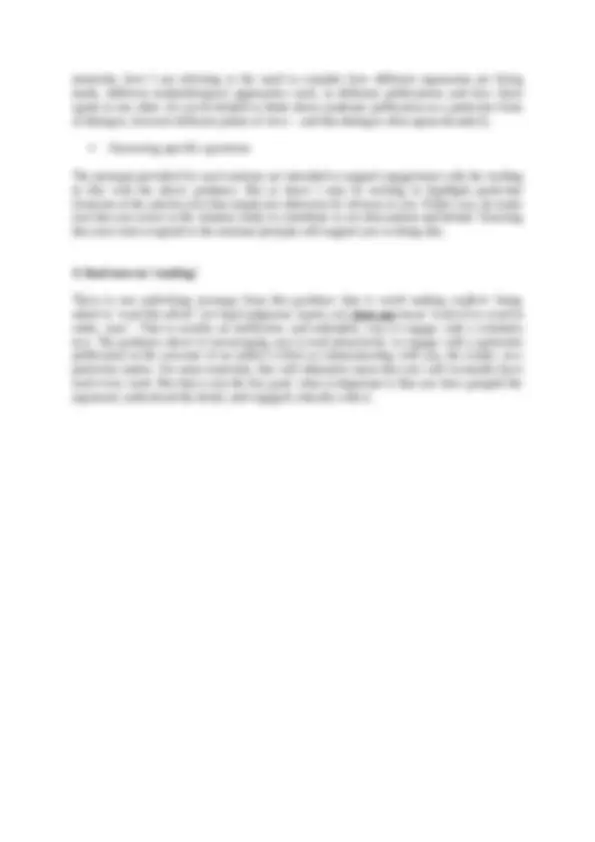



Study with the several resources on Docsity

Earn points by helping other students or get them with a premium plan


Prepare for your exams
Study with the several resources on Docsity

Earn points to download
Earn points by helping other students or get them with a premium plan
Community
Ask the community for help and clear up your study doubts
Discover the best universities in your country according to Docsity users
Free resources
Download our free guides on studying techniques, anxiety management strategies, and thesis advice from Docsity tutors
Guidance on how to read and engage with journal articles related to penal policy for the laws3074 module. It offers prompts to help students understand the focus, approach, and arguments of articles, as well as encouraging critical analysis and interaction with other materials. Dr. Harry annison's guidance emphasizes the importance of efficient and proactive reading.
Typology: Exercises
Uploaded on 06/03/2020
3 documents
1 / 2

This page cannot be seen from the preview
Don't miss anything!


Guidance on Reading Penal Policy LAWS Dr Harry Annison In this module we will draw on a range of materials, including: textbook chapters journal articles policy reports blog pieces While you may be familiar with many of these resources already, it may be useful to offer some guidance on how to engage with the readings for Penal Policy. This may be particularly useful in relation to journal articles that have their foundations in social theory, sociology, politics, socio-legal studies and other approaches with which you may be less familiar. Reading a journal article This guidance is provided for journal articles, but similar principles can be applied to reading any of the materials we will encounter during this module. When reading a journal article, it is useful to ask yourself – and base your notes around – the following prompts: What is the article about? o What is its focus? (topic, geographical area, existing literature) o What approach does it take? (for example: is it based on analysis of legal judgments, interviews with policymakers, theoretical analysis of existing literature) o Are there particularly important concepts used? If so, how are they defined? o What is the author’s argument? (ie what is the point of the article) In responding to these prompts, it is usually best first to read the abstract (if available), introduction and conclusion of the article. This should give you a good overall sense of the article. You can then navigate the paper using the headings (if provided), in order to answer the above prompts. Critical analysis o Do you find the author’s argument intuitively persuasive? Why? o What are the stronger aspects of the article? o What are the weaker aspects of the article? o How does this article ‘interact’ with other materials you have read? These prompts are encouraging you to engage critically with the article. When we speak about its ‘stronger’ and ‘weaker’ aspects, this could relate to its methodological rigour (eg the research just hasn’t been conducted very well, or alternatively is clearly very rigorous) or the persuasiveness of the argument. When we speak about the article ‘interacting’ with other
materials, here I am referring to the need to consider how different arguments are being made, different methodological approaches used, in different publications and how these speak to one other. (It can be helpful to think about academic publication as a particular form of dialogue, between different points of view – and this dialogue often spans decades!). Answering specific questions The prompts provided for each seminar are intended to support engagement with the reading in line with the above guidance. But at times I may be seeking to highlight particular elements of the articles (etc) that might not otherwise be obvious to you. Either way, do make sure that you arrive at the seminar ready to contribute to our discussions and debate. Ensuring that your notes respond to the seminar prompts will support you in doing this. A final note on ‘reading’ There is one underlying message from this guidance that is worth making explicit: being asked to ‘read this article’ (or legal judgment, report, etc) does not mean ‘read every word in order, once’. That is usually an inefficient, and unhelpful, way to engage with a scholarly text. The guidance above is encouraging you to read proactively: to engage with a particular publication as the outcome of an author’s effort at communicating with you, the reader, on a particular matter. For some materials, this will ultimately mean that you will eventually have read every word. But that is not the key goal: what is important is that you have grasped the argument, understood the detail, and engaged critically with it.